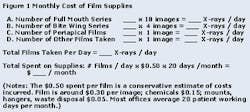The bottom line
by Jeffrey B. Dalin, DDS, FACD, FAGD, FICD
In my last two columns, we have explored the world of digital radiography — in particular, the benefits for your practice and the benefits for your patients. If any of you remain uncertain about my enthusiasm for this technology, let me reiterate that I regard digital radiography as being the cornerstone of any dental office that seeks to venture into the digital world.
This is my last column on digital radiography, and this time I want to discuss something close to all of our hearts — the bottom line. How much does it cost, and who should get involved? Can you afford this technology? More importantly, can you afford not to have this technology? I think many of you will be surprised at how the numbers work out!
Let's start by considering the economics of traditional film-based radiographs:
Fixed costs: You need X-ray heads, a darkroom space, and a film processor. These items tend to be fairly large capital investments.
Variable costs: Consider the cost of films, mounts, and chemicals (e.g., developer, fixer, waste disposal). Also, consider the staff cost for developing and mounting films.
Operatory costs: There is the cost of keeping your operatory tied up and unavailable for other patients while you are waiting for the films to be developed.
To illustrate the impact on your practice, let's look at the numbers. Go ahead and enter typical figures for your practice. You may want to seek some help from your staff members with the figures if you are uncertain about them.
To determine the cost of taking film-based radiographs, add the results of Figures 1 and 2. Most dental practices spend $300-$500 per month on the variable costs alone and don't even know it! I was quite surprised when I first discovered this fact.
Of course, there are costs involved in taking digital X-rays as well. The main difference is that with a digital radiography system there are no recurring, disposable items to purchase. Film, mounts and chemicals become a thing of the past. Staff costs are dramatically reduced (staff members are deployed to more productive activities) as images are created instantaneously.
The main costs incurred in digital radiography revolve around the initial purchase of the electronic sensor and capture device, the use of a computer and monitor, and the software. There are some ongoing costs for the annual maintenance contract, but these are not that significant ($1,000-$1,500 per year).
How you purchase a digital radiography system is an important decision. Some doctors like to purchase their system outright and have very low costs going forward. Other doctors like to lease — in this instance, the payments on a five-year lease can average $275 — $350 per month, which, not surprisingly, is highly comparable to the monthly cost of film-based radiographs!
I have heard many of my colleagues say that while they would love to have digital radiography in their practice, they cannot afford its high price tag. I understand their dilemma. However, when I help them do the simple analysis of how much they are already spending each month with conventional film, most of them agree that this is not a strong argument.
The bottom line is digital radiography simply makes both good diagnostic and financial sense. As I like to say, it is better for your patients and better for your practice. In the next issue, we will leave the world of digital radiography and move on to explore another digital technology — digital photography.
Jeffrey B. Dalin, DDS, FACD, FAGD, FICD, practices general dentistry in St. Louis. He also is the editor of St. Louis Dentistry Magazine and spokesman and critical-issue-response-team chairman for the Greater St. Louis Dental Society. His address on the Internet is www.dfdasmiles.com. Contact him by email at [email protected], by phone at (314) 567-5612, or by fax at (314) 567-9047.
'The Internet' Lives!
For those of you who have written in wondering where Dr. Jeff Dalin's column on "The Internet" has gone, it has moved to a new home on our newly designed Dental Economics Web site. Visit it often to pick up valuable information on Internet use, as well as lists of interesting and helpful sites to visit.
Viruses have been creating havoc on many dentists' computers. To learn preventive steps to take, read Dr. Dalin's current column at www.dentaleconomics.com.
Also be sure to check out www.dentaleconomics.com for the latest news updates, as well as daily news items from newspapers and wire services throughout the world and new product information.


